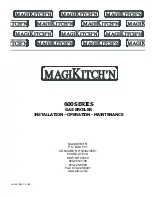
Quick Reference Installation Guide
For gas delivery to the boiler, we recommend using
hard piping rather than flexible piping. If you use
flexible piping, ensure that the gas pipe size is
appropriate for the maximum BTU input of the boiler.
Minimum Gas Pressure
4" w.c.
Maximum Gas Pressure
14" w.c.
Size piping for sufficient sustained gas delivery at
sufficient pressure to the boiler.
Recommended Supply Pressure at Full Load
Natural Gas
7"
Propane
10"
•
Ensure that there is a minimum of 6 feet of piping
between the boiler and gas regulators.
•
Use a manometer to test that gas delivered to the
boiler is delivered at sufficient pressure and that
“lock up” does not exceed the maximum pressure.
•
If using a 5 psi to inches vented gas regulator,
always oversize the vent pipe to prevent hunting
of the gas regulator when boilers are firing at
lower output levels.
• We strongly recommend against using copper gas
lines. In retrofits with existing copper gas pipes,
we highly recommend replacing the pipes with
black iron or stainless steel piping sized correctly
for the boiler. If the copper gas pipes must remain,
clean and clear the gas piping of any debris before
connecting to the boiler. Failure to do so can
result in a blocked gas valve. and inconsistent
performance.
Maximum Pipe
Length by Model
½"
IPS
¾"
IPS
1"
IPS
1¼"
IPS
CX 150 (Natural Gas)
20’
80’
200'
900’
CX 150 (Propane)
50
'
200'
600
'
2,000’
CX 199
(Natural Gas)
10'
40'
150'
900'
CX 199
(Propane)
30'
125'
400'
1,400'
1.
Place the vacuum breaker cap over the
vacuum breaker opening and push firmly
2. Fill the condensate trap with water.
3.
Attach the trap to the drain hose, and tighten
the drain compression (including washer)
4.
Slide the trap over the boiler drain outlet, and
tighten upper union nut. Secure the upper
union nut with the outlet clip.
5. Check for leaks.
Gas Supply
(
Section
3.12
)
Boiler Mounting
(Manual
Section 3.4
)
Venting
(Sections 3.5 and 3.7)
•
Ensure that sidewall configurations have a minimum
12" vertical separation, and that exhaust plumes are
well away from all building air intake vents.
• Ensure that all venting material is sloped towards
the boiler. PP venting must be sloped at a minimum
of ⅝″ per foot to ensure that no leaks occur via
gaskets.
•
Ensure that PP venting is supported every 36″ (min).
•
On longer horizontal runs of PVC and CPVC,
increase the grade to ⅜″ or more.
• Fully insert approved venting material into the
boiler’s exhaust outlet. Then, tighten the clamp
to lock the venting in place. For PP venting, a
transition adapter is not required.
• Pull on the venting to check it’s securely attached to
the boiler exhaust outlet.
Important:
To protect against wind loads,
terminate exhaust venting as shown, or use the
appropriate direct vent kit.
Condensate Trap
(
Section
3.9
)
LWCO Errors
To clear LWCO errors caused by air:
1.
Ensure that there is no air trapped in the
boiler and boiler piping.
2.
On the touchscreen controller
Status
Menu,
go to
Clear Errors
>
Yes
1.
Ensure that the boiler’s mounting bracket is
securely bolted to the wall structure.
2. Fasten the bottom of the boiler to the wall.
Important:
Not applicable for construction
heating. Parts such as fans, burners, and
ignitors fouled by construction are not covered
under warranty.
120-414E1 CX Quick Start




















